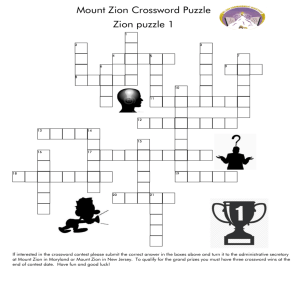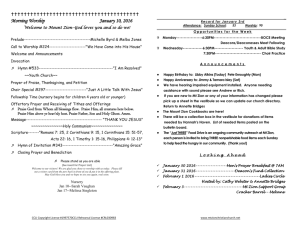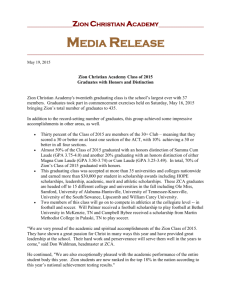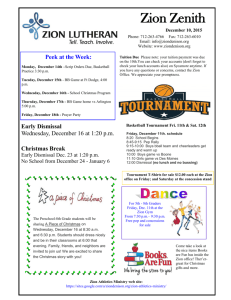Zion National Park - Brown-Leach15
advertisement
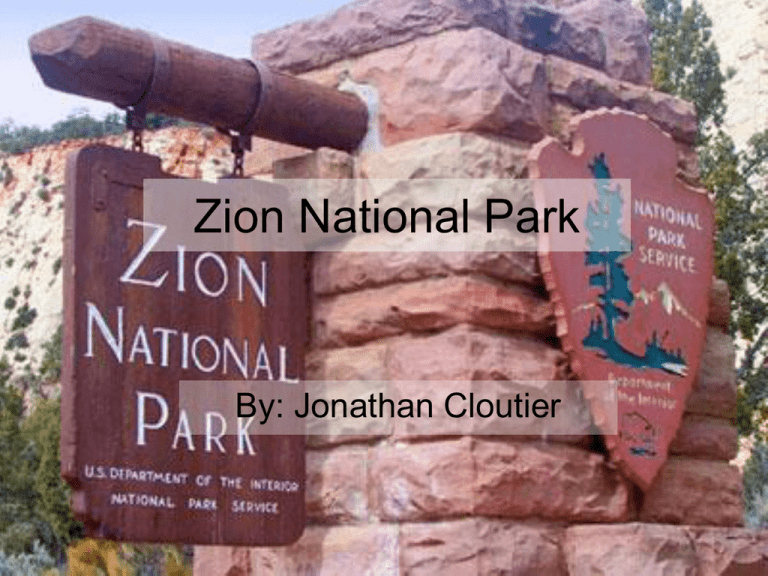
Zion National Park By: Jonathan Cloutier Relief Map Relief Map of Zion National Park (Landforms and features such as canyons and rivers are identified) Country Map Map of Zion National Park located in the USA Why Zion Became A National Park Zion became a national park in 1919 and it was Utah's first National Park. Zion became a National park to protect 3 separate ecosystems which include more than 900 species of plants not found anywhere else in Utah. It was also a National Park because it was a beautiful area of land for tourists to visit. Soon after the state of Utah began paving a state highway which was followed by a railroad. By the summer of 1917 touring cars could finally bring visitors to Zion Canyon. Environmental issues affecting Zion A few environmental issues affecting Zion are: • Automobile congestion: 4,000 to 5,000 vehicles enter the park yet there are only 400 parking spaces. • noise pollution: noise from automobiles is bouncing off the canyon walls to disrupt tranquility. • damage to vegetation near the roads: from cars, cyclists and pedestrians. • human littering and waste: pedestrians walking the trails constantly leave trash along the paths. Special landforms and Features in Zion In Zion there are many amazing landforms and land features. That includes ancient paths that native people and pioneers walked a long time ago. There is also massive sandstone cliffs that could amaze you for hours, accompanied by really beautiful canyons. For example, Zion Canyon has a deep chasm with almost vertical walls that are so narrow that sunlight can barely get to the bottom. There are rivers such as the Virgin River, that show erosion with waterfalls and rapids. The highest point is Horse Ranch Mountain, which is 8,726 feet above sea level, it is located north of the Kolob Finger canyons. The lowest point is called South Camp Ground which is 3,900 feet above sea level. How Tech is Used in Zion There are many forms of technology in Zion. For example, they have clean running propane buses to shuttle visitors and reduce automobile traffic, noise and pollution to other visitors. Their visitor center is a energy efficient building that protects the environment. They also created the Green Fleet Bicycle Project to encourage using bicycles for short trips to reduce vehicle emissions. Types of Rock in Zion In Zion there are multiple kinds of rocks. The most common is sandstone and usually appears around cliffs. Sandstone is a primary sedimentary rock. Another very common sedimentary rock is limestone and it is usually found near or at cliffs. Siltstone is found mostly in cliffs and slopes, and it is a sedimentary rock. Sandstone Siltstone Limestone Formation of Zion Zion is more than 250,000,000 years old, and it was formed in a very interesting way. A long time ago all of Zion was a huge desert basin that was covered in a large amount of slowly moving streams. These massive rivers carved their way through the terrain. As time passed, the earth shifted causing the Plateau to move up slowly, making the sea drain away. The 2,000 foot cliffs are now all that is left of those massive sand dunes. Now the park includes canyons, plateaus, rivers, and waterfalls, and it is constantly changing with each passing decade. How is Zion Changing Zion is changing in a few ways. One way is that the streams rapidly fall of the plateau into the rock. Those streams carry sediment and large rocks that form deep and narrow canyons. At one time, a landslide created a dam in the Virgin River to form a lake. At some point the lake drained to form a valley. In 1995 a land slide damaged the road in the valley. Since then there have been multiple flash floods that have increased the water volume in the Virgin River, damaging the scenic road and valley. Bibliography "Zion National Park." - New World Encyclopedia. N.p., n.d. Web. 18 Jan. 2016. "World Easy Guides." N.p., n.d. Web. "Geology." Zion National Park Geology Comments. Zion National Park, n.d. Web. 18 Jan. 2016. Seek, Ryan. "Road to Zion." Fine Art America. N.p., n.d. Web. 18 Jan. 2016. "Where to Next?" Where to Next. N.p., n.d. Web. 18 Jan. 2016. Friedman, Bruce. "Massive Sandstone Cliffs Of Zion - Zion National Park - Utah by Bruce Friedman." Fine Art America. Fine Art America, n.d. Web. 18 Jan. 2016. " Zion's Shuttles Are Environmentally Friendly!" Parks Transportation, Inc. N.p., n.d. Web. 24 Jan. 2016. Levy, Paul. "Paul Alan Levy's Blog." : Hiking the Northern Part of Zion National Park, and Sightseeing around the Highway 9 Tunnel. N.p., n.d. Web. 24 Jan. 2016. "Zion National Park." Pintrest. Pintrest, n.d. Web. 24 Jan. 2016. "Streams, Waterfalls, and Water." Pintrest. N.p., n.d. Web. 24 Jan. 2016. <https://www.pinterest.com/cengeling/streams-rivers-andwaterfalls/>. "Zion National Park." History. Utah's Dixie, n.d. Web. 25 Jan. 2016. <http://www.utahsdixie.com/zion_national_park.html>. "Zion National Park - National Geographic." National Geographic. N.p., n.d. Web. 25 Jan. 2016. <http://travel.nationalgeographic.com/travel/national-parks/zion-national-park>. "History." Zion National Park History Comments. N.p., n.d. Web. 25 Jan. 2016. <http://www.zionnationalpark.com/explore/guidebook/history/>. United States. National Park Service. "Zion National Park (U.S. National Park Service)." National Parks Service. U.S. Department of the Interior, 19 Jan. 2016. Web. 25 Jan. 2016. <http://www.nps.gov/zion/index.htm>. "Zion National Park | GORP.com." Gorp.com. N.p., n.d. Web. 25 Jan. 2016. <http://www.gorp.com/parks-guide/zion-national-park-outdoorpp2-guide-cid9451.html>. "Highlighting High Performance: Whitman Hanson Regional High School; Whitman, Massachusetts." (2006): n. pag. Zion National Park History Center. Web. 25 Jan. 2016. "Zion National Park Impact Grant." National Park Foundation. N.p., 16 Mar. 2012. Web. 25 Jan. 2016. <http://www.nationalparks.org/ourwork/success-stories/zion-national-park-impact-grant>. "Zion." NPS: Nature & Science» Geology Resources Division. N.p., n.d. Web. 25 Jan. 2016. <http://nature.nps.gov/geology/parks/zion/index.cfm>. "Zion National Park." : Kolob Canyon of Zion National Park. N.p., n.d. Web. 26 Jan. 2016. <http://justjoep.blogspot.com/2011/09/kolobcanyon-of-zion-national-park.html>. Bibliography (continued) "Mini Me Geology Blog." » What Would You Do With A Sandstone Rock? N.p., n.d. Web. 26 Jan. 2016. <http://www.minimegeology.com/blog/2011/10/19/what-would-you-do-with-a-sandstone-rock/>. "Limestone." Sandatlas. N.p., n.d. Web. 26 Jan. 2016. <http://www.sandatlas.org/limestone/>. "Common Rocks of the California Coast Ranges." Geology Cafe.com. N.p., n.d. Web. 26 Jan. 2016. <http://geologycafe.com/rocks/siltstone.html>. "Zion National Park." - Things to Do in Zion. N.p., n.d. Web. 26 Jan. 2016. <http://www.visitutah.com/places-to-go/most-visitedparks/zion>. Duncan, Dayton, and Ken Burns. The National Parks America's Best Idea. United States: National Parks Films, 2010. Print. "Redirect Notice." Redirect Notice. N.p., n.d. Web. 26 Jan. 2016. <https://www.google.com/url?sa=i&rct=j&q=&esrc=s&source=images&cd=&ved=0ahUKEwjVtoXfj8jKAhXin4MKHaZ9DPYQjRwIBw &url=http%3A%2F%2Fwww.taospaint.com%2FAnimals%2FOnOurTrip.html&v6u=https%3A%2F%2Fs-v6exp1ds.metric.gstatic.com%2Fgen_204%3Fip%3D216.11.6.192%26ts%3D1453833100443775%26auth%3D3ot2u7lw3rnwmgzchcijgoh pyxpckirq%26rndm%3D0.0015926286578178406&v6s=2&v6t=385801&bvm=bv.112454388%2Cd.amc&psig=AFQjCNG97k4MlYXc vfROgW92ER416ekK8g&ust=1453919737413847>. "Redirect Notice." Redirect Notice. N.p., n.d. Web. 26 Jan. 2016. <https://www.google.com/url?sa=i&rct=j&q=&esrc=s&source=images&cd=&ved=0ahUKEwjw67DrksjKAhVsvIMKHbEKCCMQjRwIB w&url=http%3A%2F%2Fwww.visitstgeorge.com%2Fzion-nationalpark%2F&bvm=bv.112454388%2Cd.amc&psig=AFQjCNEsoxswnwz_Q-i4x9XRgdabFgu0SQ&ust=1453920698473123>. "Zion National Park - Utah." Zion National Park: Climate, Geography, Map. DesertUSA, 1996. Web. 26 Jan. 2016. <http://www.desertusa.com/zion/du_znpmap.html>. Milligan, Tanya. "Zion National Park Geology." Geology Zion National Park -. N.p., n.d. Web. 26 Jan. 2016. <http://www.zionnational-park.com/zion-national-park-geology.htm>.


